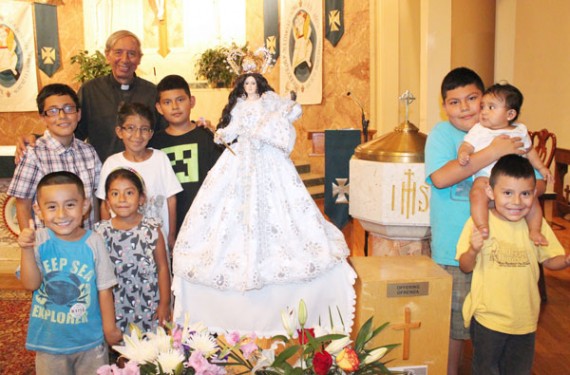
As part of a week-long veneration in honor of the Virgin of Cisne, Ecuadorians from St. Leo’s parish, Corona, organized a series of novenas and a cultural celebration from Sept. 16 to 25.
Members of the parish gathered each night to pray before the image of the Virgin, which was brought from the basilica in El Cisne in the southern province of Loja, Ecuador. A gala procession concluded the celebration.
The final day featured Mass followed by music, dancing and the serving of Ecuadorian dishes in the church yard.
“The community has really come forth all week, especially the Ecuadorian community because even though there are different groups, they still venerate the same image,” said Father Diego Villegas, parochial vicar. “All the groups came together for this celebration, and everything has been done in less than a month.”
Corona has the highest concentration of people of Ecuadorian descent in the Diocese of Brooklyn, which is why St. Leo was chosen as the host site for the celebration. Corona also shares a name with one of the three main cities of Ecuador – along with Quito and Guayaquil.
The image of the Blessed Mother, adorned with curly black hair and a long white dress, represents traditional Ecuadorian culture. During the novenas, parishioners shared special prayer intentions to the Mother of God.
“Everything is done through the Mother for the love of the Son and the Son through the love of the Mother,” Father Villegas said.
Dates Back to 16th Century
The Virgin of Cisne traces its origins to 1594 when city representatives commissioned sculptor Don Diego de Robles to build a six-foot statue of the Virgin from a cedar tree so native Ecuadorians could practice their devotion to the Blessed Mother.
Later that same year, the province of Loja experienced a drought. In addition to no rain and dry ground, a plague of mice consumed whatever remaining food the villagers had.
The residents decided that the only way to survive would be to abandon their town. They gathered to pray before the Virgin of Cisne statue, asking to stay in their homes and, if they had to leave, that the Mother would watch over them.
As they packed up the statue and began to leave, a windstorm struck the town, forcing them to return home.
The Virgin then appeared to the village elders telling them not to leave and that if they built a church, she would watch over them.
Soon after, the rain ended the drought and starvation period. The people then built the Cathedral of El Cisne along with a shrine that housed the statue, which is still venerated to this day over 400 years later.
Pilgrim Flock to El Cisne
Each year on Aug. 17, thousands of pilgrims gather in El Cisne for a three-day procession to the cathedral, as they honor the Virgin as the patroness of the province of Loja and of all exiles.
“In Ecuador, the Virgin of Cisne is huge,” said Narcisa Tacuri, a parishioner at Our Lady of Sorrows. “The people of Ecuador put all of their hearts, intentions and prayers to her because they can’t worship the Son without praying to the Mother as well. She is an important model to them.”
While Ecuadorian culture was mainly on display, members of the entire Latin American community joined together.
“First and foremost as a Guatemalan, I am extremely humbled to see so many people come to worship the Virgin,” said Luis Maldonado, a parishioner at St. Leo’s. “As a Hispanic, I feel it’s important to learn about other people’s cultures and the way they believe.”
